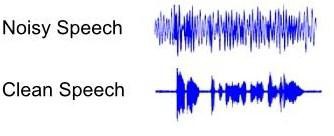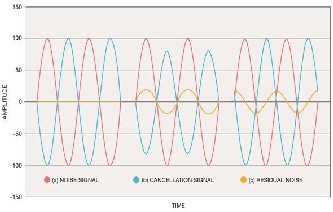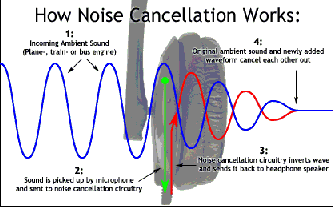International Journal of Scientific & Engineering Research, Volume 5, Issue 7, July-2014
ISSN 2229-5518
809
A Comprehensive Study of Ambient Noise
Reduction in Mobile Phones
Chandra Srinivas Potluri, Sreedevi Kadiyala
Abstract – Using a mobile handset is noisy environments makes the far end speech difficult to be perceived from the near-end user perspective. As, the person is surrounded by a loud back ground noise, the handset user needs to concentrate hard to understand the far-end speaker conversion. There are numerous noise cancellation solutions that filter and improve the voice signal from the microphones and create a high quality transmission from one to the other person on the call. Active and passive noise cancelling technologies can minimize background noise in high end headphones; however these technologies today cannot provide the same benefits in mobile handsets. Active noise cancellation (ANC) has been used in headphones for several years, often used to cut out the drone of an aircraft on a long journey. But the full benefit of the technology has not been realized the potential is for noise cancellation to be used in a much wider range of applications creating a field of quiet for users of a range of consumer equipment. A highly effective noise cancelling scheme would not only benefit consumers by helping to save our hearing, but carriers would benefit from longer calls, more calls and more satisfied consumers resulting in higher revenues.
Keywords – Active Noise; Ambient Noise Cancellation (ANC); Ambient Sound; Clean Speech; Mobile Phones; Noise Cancellation Signal; Clean
Speech; Passive Noise
—————————— ——————————
1. INTRODUCTION
n current mobile phone handsets the voice signal that is taken in from the microphone in the phone can be filtered and improved, creating a high quality link from
you to the other person on the call, but receiving a call in a busy place can make the voice of the person calling you inaudible. Being able to create a field of quiet around the handset ear piece without relying on impractical passive noise cancellation, is a particularly exciting possibility for mobile phones.
The technology of ANC has moved down from the high end into mid-range headphones, but it has remained pretty much in headphones. Part of the problem has been the feedback ANC technology that most of these headphones use. This technology tries to create a stable null; a microphone measures the noise inside the headphone ‘cans’ and a circuit generates a cancellation signal which is sent to the headphone speaker. However this technique is limited in the frequencies that can be cancelled, and most often it needs significant sound proofing around the earphones to block out the external noise through passive noise cancellation.
2. RELATED WORK
2.1 Mobile Phones
————————————————
Chandra Srinivas Potluri is currently pursuing M.Phil in Computer Science, Bharathiar University, India. Working as an Asst. Professor in Debre Berhan University, Ethiopia. E-mail: pcsvas@gmail.com
Sreedevi Kadiyala is currently pursuing Ph.D in Computer Science in JNT University, India. Working as an Asst. Professor in Debre Berhan University, Ethiopia. E-mail: sreedevikadiyala@gmail.com
In In current mobile phone handsets the voice signal that is taken in from the microphone can be filtered and improved, creating a high quality transmit link from you to the other person on the call. But receiving a call in a busy place can make the voice of the person calling you unintelligible.

Imagine a scenario when we are walking past some really loud road works whilst on the phone. Only a few years ago this would have meant that a mobile call would have been nigh-on impossible as you get drowned out by the machinery. Old feature phones particularly struggled in this area, unable to cope due to single microphones and the lack of power that sat underneath the hood. The following figure depicts the difference between noisy speech and clean speech.
Fig 1. Noisy Speech and Clean Speech
2.2 Ambient Noise Cancellation (ANC)
The basis of electronic ambient noise cancellation is destructive wave interference between the unwanted noise signal and a “cancellation” signal that is created to be equal in magnitude to the noise signal and opposite in phase to it. This is shown on the left of Figure 1, which depicts a sine wave noise signal and its cancellation counterpart and also
IJSER © 2014 http://www.ijser.org
International Journal of Scientific & Engineering Research, Volume 5, Issue 7, July-2014
ISSN 2229-5518
810
the remaining residual noise that results from this interaction. The cancellation is perfect and the residual noise signal is zero. This seems like a simple approach, however it is interesting to consider what happens when the amplitude and phase characteristics of the unwanted noise and cancellation signals are not perfectly matched.

Fig 2. Effective noise-cancellation requires accurate alignment of the noise signal to the cancellation signal.
ANC is an attractive feature for makers of high end phones for developed markets. Imagine a business phone that lets you clearly hear the information that a colleague is communicating to you when you are on a noisy train, or a phone that allowed you to receive a friend’s call in a busy restaurant without needing to go outside to hear them. But this approach is also of interest to the low end phone makers and network operators in developing markets where callers are often struggling to complete calls in very noisy street environments. Also, using technology in the handset to improve the quality of the call means that the network can stretch further for the same level of signal quality, either bringing phones to more customers with the same infrastructure equipment or reducing the roll out of new infrastructure equipment. Implementing this technology in mobile phones is a very significant challenge, not only in making the technology work, but to make it work cost effectively for designs that are manufactured in the tens of millions of units. That is not a trivial challenge.
3. TYPES OF NOISE CANCELLATION
Passive noise cancellation involves insulation and absorption, typically in the form of cups or cans that surround the ear. This works fine for headphones that are used to listen to music or drown out unwanted sounds on airplanes. Clearly, passive noise cancellation isn’t practical for a mobile handset. Active noise cancellation can be classified as feedback or feed-forward. In headphones a feedback approach is typically used with passive noise cancellation. The headphone “cans” create a sealed cavity
over the listener’s ear. The noise inside the can is then
monitored using a microphone and an electronic feedback circuit is used to generate a noise cancellation signal which
tries to create a null, silence, inside the can. It is clearly not practical to create such a sealed cavity around the ear of a person using a mobile phone.
3.1 Working of Noisy Cancellation

Fig 3. Noisy Cancellation
By observing the wave representation of Noisy cancellation in Fig.3 working is as follows:
1. Incoming Ambient Sound
2. Sound is picked up by microphone and sent to noise cancellation circuitry.
3. Noise cancellation circuitry inverts wave and sends it back to headphone speaker.
4. Original ambient sound and newly added waveform cancel each other out.
4. RECEIVER SIDE NOISE CANCELLATION
The Wolfson ANC technology uses feed-forward architecture rather than the traditional feedback approach. This also uses microphones to capture the ambient noise, but instead of using feedback to create a null it inverts the noise signal and generates a field of sound timed to cancel the noise as it hits the eardrum. This avoids the need for cans around the headphones, or the need for passive cancellation at all. However, there are major challenges to this approach, both technical and commercial. There is limited time to do the signal processing, inverting the signal, calculating the time shift that is needed, and producing the output waveforms for the speaker. All this needs to be done in the time it takes for the ambient noise signal passing the noise monitoring microphones till the same signal reaches the ear. The generated cancellation signal also has to be exactly phase aligned to ensure that the noise is correctly cancelled. If done correctly this creates the field of quiet around the ear so that the audio signal is clearer regardless of the noisy environment.
The other challenge is commercial. Phones use a wide range of microphones and speakers, and such a system has to be easily designed into a specific phone. Having a
IJSER © 2014 http://www.ijser.org
International Journal of Scientific & Engineering Research, Volume 5, Issue 7, July-2014
ISSN 2229-5518
811
IJSER © 2014 http:1/www.ijser.org
International Journal of Scientific & Engineering Research, Volume 5, Issue 7, July-2014
ISSN 2229-5518
812
hear the voice call. There is also potential to integrate the signal processing with silicon microphones. Integration steps such as these would reduce the noise in the system, improve the performance, and require less power, while reducing the overall bill of materials and complexity of the phone design.
6. CONCLUSION
Active noise cancellation is a powerful tool for improving the user experience in mobile phones and also improving the economics and user satisfaction of mobile phone networks. It has not been possible to apply feedback ANC techniques to mobile phones due to the need for passive noise cancellation and the need to create a sealed cavity around the ear of the listener. With a feed forward architecture combined with the patented and novel time alignment and signal processing techniques developed by Wolfson, it is now possible to provide very effective noise cancellation in a phone at a cost that is acceptable for both high end and low end phone makers.
7. REFERENCES
[1] Monteith, D. (2008), Active Noise cancellation comes to mobile phone, [online] available from <http://www.low- powerdesign.com/article_monteith_112509.html> [6th Dec
2011]
[2] Zangi, K. C. (1993) ‘A New Two-sensor Active Noise Cancellation Algorithm’, Proceedings of the IEEE International Conference on Acoustics, Speech, and Signal Processing, held 27-30 April 1993, 351-354
[3] Oppenheim, V., Weinstein, E., Feder, M., and Gauger, D. (1994) ‘Single-Sensor Active Noise Cancellation’. Journal of Speech and Audio Processing, 2(2), 285-290
[4] Widrow, B., and Stearns., S. D. (1985) Adaptive Signal
Processing. Englewood Cliffs, NJ: Prentice-Hall.
[5] Rose, C. (2007) An Implementation of Active Noise Control for Canceling Speech, Aubun University Honors College, Alabama
[6] Zangi, K. C. (1993) ‘A New Two-sensor Active Noise Cancellation Algorithm’, Proceedings of the IEEE International Conference on Acoustics, Speech, and Signal Processing, held 27-30 April 1993, 351-354.
[7] Haykin, S. (1991), Adaptive Filter Theory. 2nd edn. Englewood Cliffs, NJ: Prentice-Hall
IJSER © 2014 http://www.ijser.org


